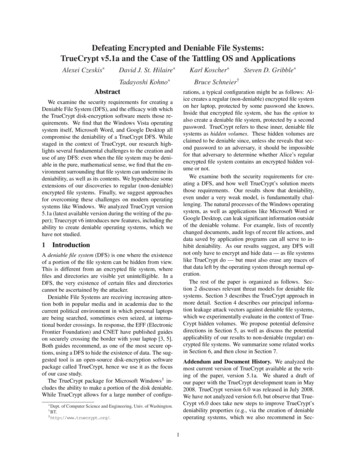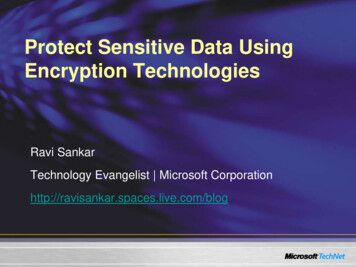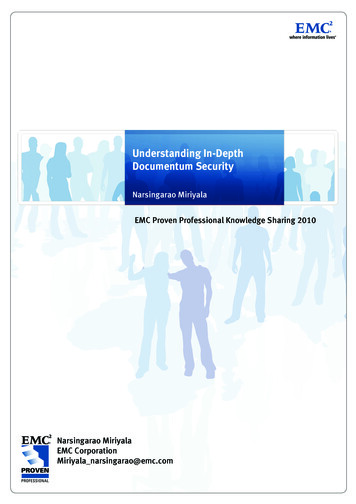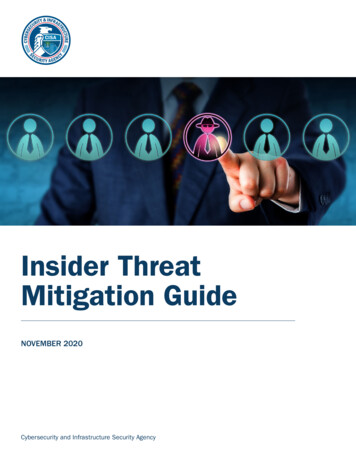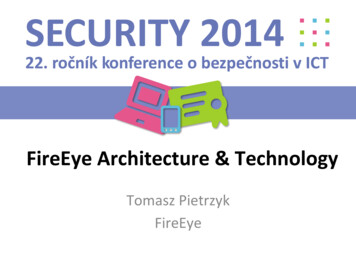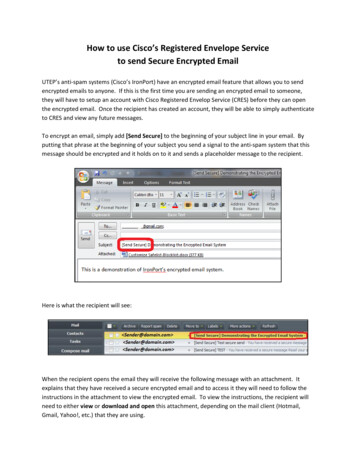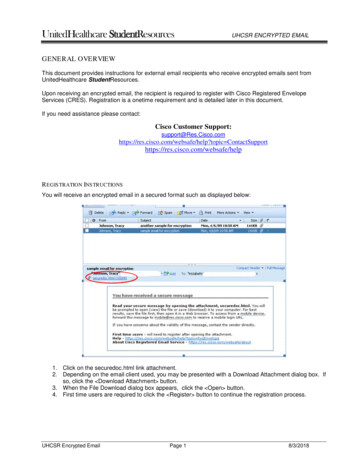
Transcription
White PaperFebruary 2005McAfee Network Protection SolutionsEncrypted Threat ProtectionNetwork IPS for SSL Encrypted Trafficwww.mcafee.com
Encrypted Threat ProtectionNetwork IPS for SSL Encrypted Trafficwww.mcafee.com2IntroductionSSL Encryption OverviewThe Need for SSLSSL Advantages and DisadvantagesLegacy SSL Intrusion Prevention Techniques33333The Need for Network IPS in the SSL EnvironmentRequirements for an Effective SSL Network Intrusion Prevention SystemIntruShield SSL Traffic Inspection and Prevention DetailsIntruShield ArchitectureSSL Inspection TechniquesIntruShield SSL Inspection CoverageIntruShield SSL Attack Prevention MethodsIntruShield SSL Packet Analysis OptionsIntruShield SSL Key Security445555666Conclusion7
Encrypted Threat ProtectionNetwork IPS for SSL Encrypted Traffic3IntroductionProtecting valuable information assets from network-based attacks is the primary function of any network intrusion preventionsystem. Until now, protection of assets that use SSL encryption technology (such as Secure HTTP) has been beyond thereach of network IPS or IDS systems. With the introduction of IntruShield v2.1, the power of network IPS now can be extendedto protect network servers that use SSL encryption to ensure the confidentiality of their transactions. IntruShield 2.1 is afirmware and software release designed to extend the power of the IntruShield purpose-built sensor. IntruShield 2.1 runs onany IntruShield hardware sensor and provides SSL decryption support on the I-4000 and I-2600 sensor models. This paper isan introduction to the benefits and techniques used to address the problems of inspecting and protecting encrypted traffic onthe network.SSL Encryption OverviewThe Need for SSLAs use of the World Wide Web began to grow in the early 1990’s, a secure mechanism to enable commercial Internettransactions became necessary. Two major requirements were identified to enable e-commerce transactions: 1) the ability forinternet consumers (clients) to reliably identify the internet vendors (e-commerce servers) with whom they were transactingbusiness, and 2) the need to protect the confidentiality of the clients’ sensitive information as it transited the Internet.Netscape communications introduced Secure Socket Layer (SSL) v2.0 in 1995 as a solution to fulfil these two requirements.SSL blends Digital Certificate technology for reliable identification of the target server, with encryption for protection of theconfidentiality of information as it passes between the client and the server.SSL Advantages and DisadvantagesThe success of SSL in e-commerce is a testament to the advantages of the technology. Using the common Web browser asthe primary client software simplifies support requirements by eliminating the need for additional software applications.Authentication of the target SSL Web server is transparent to the end user and is fairly reliable. Encryption algorithms haveevolved with the technology to provide a high level of security with the availability of 128-bit and higher keys.There are some fundamental disadvantages with the technology when examined from a Network or server securityperspective. Authentication with SSL is achieved with the identification of the server by the client via a Digital Certificate that isissued and signed by a Certificate Authority (CA) and stored on the server. Identification and authentication of the clientaccessing the server, although possible, is not practical for the purposes of e-commerce since the vast percentage of clientsdo not have Digital Certificates that are signed by a registered CA. Without a certificate signed by a CA, reliable identificationof the client to the server is not possible. This can lead to a situation where an anonymous client on the Internet can connect tothe SSL server, establish an encrypted session and then use this session as a secure channel for attacking the specific Webserver associated with the session. The encrypted SSL connection has traditionally prohibited network security ormanagement personnel from inspecting the contents of the session prior to its termination at the SSL concentrator or the WebServer that terminates the SSL session.Legacy SSL Intrusion Prevention TechniquesHistorically the only practical method for protecting against SSL-encrypted attacks has been with the use of host IPS solutions.Host IPS solutions reside on the server itself and either inspect the traffic coming into the host after it has been decrypted, ormonitor the behavior of the underlying system to mitigate an attack after it has entered the system. While host IPS provideseffective system-level protection for encrypted threats, enterprises need a method to proactively prevent encrypted attacksfrom compromising critical SSL-enabled infrastructure. This would provide an additional layer of protection and would addflexibility for network security professionals. In order to achieve comprehensive protection against those attacks hidden withinencrypted connections, enterprises need to adopt a layered approach that includes proactive network protection for criticalinfrastructure while assuring business availability and data confidentiality.www.mcafee.com
Encrypted Threat ProtectionNetwork IPS for SSL Encrypted Traffic4The Need for Network IPS in the SSL EnvironmentBy its very nature, information that requires protection via SSL is“critical” data. HTTP is one of the most popular protocols forattackers since it must be made publicly available to be useful. Notonly is it important to protect the sensitive data that resides on theWeb server itself, but modern e-commerce sites typically accessinformation stored on database servers that live at the very core ofthe network. Protecting the SSL-enabled Web server fromcompromise not only safeguards the data local to the Web server,but helps to eliminate a potential attack channel into the heart of the“trusted network”. To effectively access data that resides at the coreof the network, the Web server must be granted some level of trustthrough the firewall to the core assets. If the “trusted” Web server iscompromised and taken over by an attacker, the trust relationshipcan be used for penetration of other valuable assets within thenetwork.SSL Protects the Data, Not the ServerLegacy IDS/IPS Blind toEncrypted AttacksEnd-to-endEncrypted SSLSessioneCommerceServerNetwork IPS provides protection for the SSL-enabled e-commerceinfrastructure from attacks against the underlying Web server software via the encrypted SSL tunnel. Network IPS provides ahost platform neutral solution that runs with virtually any SSL-enabled server. By enabling protection at the network level,server resources are conserved for processing of user requests, thereby minimizing the complexity and associated fragility ofthe server environment.Requirements for an Effective SSL Network Intrusion Prevention SystemThe following outline critical requirements for an effective, mission-critical SSL network IPS:Accuracy—In today’s dynamic threat environment, accurately detecting malicious traffic is critical to networkoperators. Although false-positives from a network IDS may result in unnecessary alerts and create an annoyance,false-positives from a network IPS are more critical since they can result in the blocking of legitimate network traffic.To reliably block malicious traffic while allowing normal traffic to flow requires a sophisticated system that utilizes andintegrates multiple detection technologies, and supports extremely granular security policy applications.Security—The core tenant of SSL and its constituent authentication and encryption components is the protection ofthe servers’ private key. If the confidentiality of this key is compromised, the authentication and encryption functionsof the system are rendered useless. Any viable solution must preserve the confidentiality and integrity of the privatekey to be effective. Any system is only as strong as its weakest link. Security must be designed into all aspects of thesystem. Features that should be present in the system to maximize the overall security posture of the organizationinclude effective audit capabilities, control of operator access, and the encryption of traffic between all components ofthe system.Performance—Any solution that is introduced into the data path of critical assets must be capable of performing itsfunction without introducing any significant latency into the system. Although HTTP transactions are more tolerant ofdelays in the transmission path than many protocols, speed equals capacity for an e-commerce site. Any significantdelay will require the deployment of further Web servers to maintain transaction capacity, increasing costs andcomplexity and decreasing the efficiency of the overall system.Reliability—Reliability is required for any system designed to be deployed in-line with the data path, particularly withhigh value SSL based systems. A highly reliable architecture with fail open and redundant high availability capabilitieswww.mcafee.com
Encrypted Threat ProtectionNetwork IPS for SSL Encrypted Traffic5are critical to ensure minimal down time. Costs for down time on e-commerce systems can often be calculated in thetens to hundreds of thousands of dollars per minute.IntruShield SSL Traffic Inspection and Prevention DetailsIntruShield ArchitectureThe IntruShield system is designed with a three-tier architecture. The sensor is a highly reliable, purpose-built appliancedesigned for wire-speed performance with all detection capabilities enabled. The middle tier consists of a dedicatedmanagement server that provides full configuration and monitoring functions to all sensors deployed in the network. TheManager can be deployed on the host platform and hardware that best suits the customers’ needs. The Manager supportsboth Windows and Sun Solaris platforms. The Manager also supports MySQL with the Intel platform and Oracle with the Sunor Intel platforms. The client system consists of a fully Web-enabled browser-based client. All components of the systemcommunicate via secure, encrypted communications links.SSL Inspection TechniquesIntruShield inspects the SSL data stream by securelystoring a copy of the server private key on the sensor.When a client initiates a connection request to the SSLserver, IntruShield recognizes the SSL session request andmonitors the SSL session initiation transaction between theclient and the server. During the SSL sessionestablishment phase, IntruShield uses the server’s privatekey to decrypt and inspect the data and to determine thesession keys. With these session keys, the IntruShieldsensor can decrypt data packets for the life of the SSLconnection. As an encrypted packet enters the sensor,IntruShield copies the encrypted packet, decrypts and theninspects the contents of the packet. The original packet istemporarily stored in a buffer in the sensor during theinspection phase.SSL Key Integrity is MaintainedThroughout the Inspection ProcessEncrypted private key of web server / SSLterminator is imported in IntruShield ManagerIntruShield Manager encryptsprivate key with sensor public keySensor receives encryptedprivate key on startupSensor stores SSL key inRAM and inspects SSL trafficfor attacksIntruShield MgrIntruShield SSL Inspection CoverageUpon conversion of the data into clear text, IntruShield processes the data through its Protocol Normalization processors,forwards the normalized results to the Protocol and Application anomaly engines, the Statistical DoS and DDoS detectionengines and finally into the signature matching engine. The results of all the engines are correlated to arrive at the finaldetection decision. Non-SSL traffic that does not trigger an alert is forwarded from the Normalization engine to the destinationtarget ensuring “clean” traffic at the protocol level. In the case of non-attack SSL traffic, the original packet is released from theinput buffer to the destination and the data from the Protocol Normalization engine is discarded. This approach ensures theintegrity of the original packet and relieves the sensor from the overhead associated with re-encrypting the packet. Thisexhaustive inspection process is implemented in the custom silicon processing engines incorporated into the sensor and isprocessed and correlated by the Real Time Operating System (RTOS) resident in firmware on the appliance.IntruShield can protect multiple SSL servers that use different private keys automatically. All SSL sessions are processed andtracked in separate input queues in the sensor. The sensor tracks these connections via the IntruShield State tables and arelationship is maintained between the active session and the private key associated with that session. Incoming packets areautomatically matched to the appropriate key for decryption and inspection.www.mcafee.com
Encrypted Threat ProtectionNetwork IPS for SSL Encrypted Traffic6Multiple security policies with the ability to support multiple, unique configurations of SSL hosts are supported via the VirtualIPS capabilities of the system. A single physical interface within the sensor may be logically subdivided by assigning subinterface designations to the physical interface. Sub-interfaces can be defined by 802.11q VLAN tags, CIDR address blocks,or even by individual IP addresses. This allows for greater accuracy when supporting a heterogeneous SSL infrastructure.Policies may be created to detect and prevent attacks that are targeted at the specific operating system or Web Serverapplications resident on the protected servers.Dedicated Management Domains can be assigned at the sub-interface level. This allows for greater control of the personneltasked with managing the security infrastructure. For example, operators can have rights assigned to one ManagementDomain while being restricted from having access to any other defined system Domains. This granularity in operator controlincreases the overall accountability and security of the installed system and may be of particular interest to organizations thatprovide SSL enabled E-Commerce services to external customers.IntruShield SSL Attack Prevention MethodsIntruShield Blocks Encrypted AttacksUpon detection of an attack, IntruShield can be configured to blockthe attack packet, allow the packet to pass while raising an alert, orallow the packet to pass without raising an alert. If an attack isdetected within the packet and the system is configured to block theattack, the original packet stored in the buffer is dropped and thesensor sends notification to the Manager to log and/or send an alertto the designated operator(s).IntruShield SSL Packet Analysis OptionsThe sensor can be configured to capture and store copies ofSSL Protecteddecrypted packets associated with an alert or block action on theeCommerce ServerIntruShield Manager. Capture configuration is available on a persignature basis, providing extremely fine control of which packetsare captured for future analysis. The SSL Packet Log feature is disabled by default. Access to the packets stored on theManager can be controlled by the Manager’s Multiple Administrative Domain feature. Creation of a separate AdministrativeDomain for the sensor segment associated with the SSL Protection feature restricts access to the captured packets topersonnel assigned access to this specific Management Domain.IntruShield SSL Key SecurityProtection of the SSL Private Key is paramount, and IntruShield uses a number of mechanisms to ensure key confidentiality.Private keys are encrypted and exported from the SSL Server in PKCS #12 format and are imported into the IntruShieldManager via portable media, writable CD, floppy disk, etc. The encrypted key is imported into the IntruShield Manager and isencrypted again with the public key of the IntruShield sensor on which it will be used. When the Sensor is configured toperform SSL inspection, the Manager pushes the encrypted key to the sensor. The sensor decrypts the key with its private keyand stores the resulting clear text SSL Private Key in volatile memory in the sensor. If someone gains unauthorized access tothe IntruShield Manager the value of the SSL Key can not be determined without the possession of the Sensor Private Keythat is generated and stored on the Sensor itself. If the Sensor is physically stolen, the unencrypted copy of the Private SSLKey is lost as soon as power is removed from the Sensor, or a re-boot of the Sensor is performed. The Private SSL Key isnever transmitted or stored in unencrypted format and only exists in an unencrypted format in volatile RAM within the Sensor.www.mcafee.com
Encrypted Threat ProtectionNetwork IPS for SSL Encrypted Traffic7ConclusionThe ability to inspect and protect SSL-encrypted traffic represents a major milestone in the Network Intrusion Prevention field.IntruShield is the first IPS solution to provide this capability while fulfilling the four major requirements for the protection ofcritical SSL encrypted information. Accuracy—By integrating all aspects of attack detection—including Protocol and Application Anomaly inspection,multi-field, multi token signature inspection, and Self Learning Statistical Anomaly DoS and DDoS Detection—IntruShield’s accurate detection technology forms the foundation for the most accurate attack prevention solution fortoday’s mission-critical in-line IPS deployments Security—Extending the benefits of Intrusion Prevention to SSL-encrypted traffic represents an unprecedentedincrease in the security of critical network assets. By ensuring the Private SSL Key is never exposed in anunencrypted form, IntruShield ensures that the confidentiality and integrity of the SSL Key is not compromised. Thisadded security enables high-confidence adoption and deployment of the technology. Performance—IntruShield sensors are powered by programmable security-focused hardware for mission-criticalperformance and attack prevention. As a result, IntruShield sensors can support thousands of signatures at wirespeed traffic rates without any packet loss, while protecting against known, zero-day, and DoS attacks for both cleartext and encrypted traffic. IntruShield delivers compelling price and performance for needs ranging from 100’s ofMbps to multi-gigabit bandwidth rates Reliability—IntruShield appliances are equipped with redundant fans and optional redundant power supplies andhave no internal hard disk drives that may be prone to premature failure. This advanced and unique architectureprovides the highest reliability in the industry. As well, fully redundant configurations with automated optical bypasscapability provide full fail-open and fail-over support and are uniquely suited for mission-critical in-line deployments.McAfee, Inc. 3965 Freedom Circle, Santa Clara, CA 95054,McAfee products denote years of experience and commitment to customer satisfaction. The McAfee PrimeSupport team of responsive, highly skilled support technicians provides tailoredsolutions, delivering detailed technical assistance in managing the success of mission-critical projects—all with service levels to meet the needs of every customer organization. McAfeeResearch, a world leader in information systems and security research, continues to spearhead innovation in the development and refinement of all our technologies.McAfee, [List all trademarks in document] are registered trademarks or trademarks of McAfee, Inc. and/or its affiliates in the US and/or other countries. Red in connection with security is distinctive of McAfee brand products. All other registered and unregistered trademarks herein are the sole property of their respective owners. 2004 Networks AssociatesTechnology, Inc. All Rights Reserved.6-NPS-ETP-002-0205www.mcafee.com
www.mcafee.com Introduction 3 SSL Encryption Overview 3 The Need for SSL 3 SSL Advantages and Disadvantages 3 Legacy SSL Intrusion Prevention Techniques 3 The Need for Network IPS in the SSL Environment 4 Requirements for an Effective SSL Network Intrusion Prevention System 4 IntruShield SSL Traffic Inspection and Prevention Details 5

